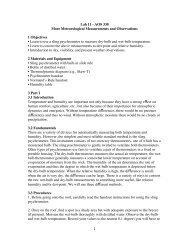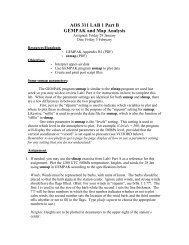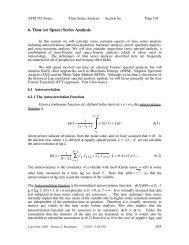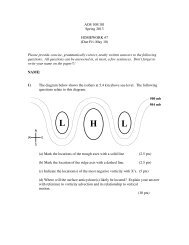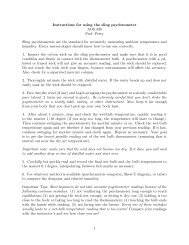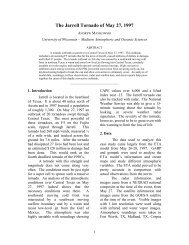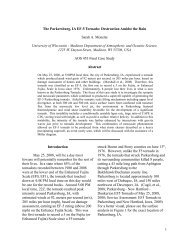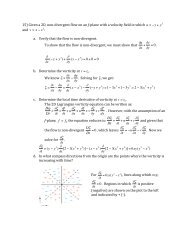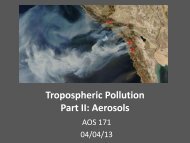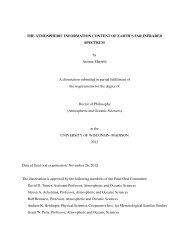R - University of Wisconsin MM5 Real Time Forecast and Forecast ...
R - University of Wisconsin MM5 Real Time Forecast and Forecast ...
R - University of Wisconsin MM5 Real Time Forecast and Forecast ...
You also want an ePaper? Increase the reach of your titles
YUMPU automatically turns print PDFs into web optimized ePapers that Google loves.
Application <strong>and</strong> interpretation <strong>of</strong>adjoint-derivedsensitivities in synoptic-casestudiesMichael C. Morgan<strong>University</strong> <strong>of</strong> <strong>Wisconsin</strong>-Madison
AcknowledgementsLinda KellerKate La CasseDr. Hyun Mee Kim (KMA)Daryl T. Kleist (NCEP/NOAA)
Goals• Describe what an adjoint model is• Demonstrate adjoint applications to– Synoptic case studies– Diagnosis <strong>of</strong> ‘key’ analysis errors– Data assimilation• Discuss interesting research problems forwhich adjoint-based tools might have someutility
Goals• Provide synoptic interpretations for selectedforecast sensitivity gradients• Describe the “evolution” <strong>of</strong> sensitivitieswith respect to the forecast trajectory• Present a useful technique to displaysensitivities with respect to vector quantities• Discuss interesting research problems forwhich adjoint-based tools might have someutility
Relationship between the nonlinear model<strong>and</strong> its adjointxin→NonlinearModel→ → R x )xout( outx ' in→LinearModel→ x ' out∂ R∂ x in←AdjointModel←∂R∂ x out
∆R=How might adjoints be used?R∂R∂x( x + x′) − R( x′) = ⋅ x′+ H . O Tf f ff .f∂R∂R∂R∆ R ≅ δR = ⋅x′f = , x′f = , Px′0∂x∂x∂xfffadjoint modelδRT ∂R= P , x′∂xf0input perturbationAn adjoint model is useful in the estimation <strong>of</strong> a changein response function associated with arbitrary, but smallchanges in the input to the linearized model.
Application #1: Synoptic case studiesImpact studiesvs.Sensitivity studies
Impact studies or “what if?” experiments• Impact studies involve studying the effects a specificinitial <strong>and</strong>/or boundary perturbation (x 0 ) to an NWPmodel has on some aspect <strong>of</strong> a forecast.• While these perturbations are <strong>of</strong>ten chosen based on“synoptic intuition”, typically the precise choice <strong>of</strong> thelocation <strong>and</strong> structure <strong>of</strong> the imposed initialperturbations is not known.• The chosen perturbations may have very little impacton the weather system <strong>of</strong> interest.• As these studies are performed to assess theimportance <strong>of</strong> a particular synoptic feature, manyintegrations are needed to yield useful results.
Modeling System Used• <strong>MM5</strong> Adjoint Modeling System (Zou et al. 1997)with non-linear model state vector:x = ( u,v,w,T,p', qv)• All sensitivities were calculated by integrating theadjoint model “backwards” using dry dynamics,about a moist basic state.• The corresponding adjoint model state vector is:∂R∂x∂R= (∂u∂R∂R∂R∂R, , , , )∂v∂w∂T∂p'
Description <strong>of</strong> Case 1 <strong>and</strong> response functions• Cold frontal passage over the upper midwest duringthe 36h period beginning 1200 UTC 10 April 2003• Sensitivity gradients were calculated for the 36hour <strong>MM5</strong> forecast from Eta model initialconditions at 1200 UTC 10 April 2003 for threeresponse functions:– 1) average temperature over WI– 2) average north-south temperature differenceover northern WI– 3) average zonal wind over WI
Mean sea level pressure <strong>and</strong> temperature (σ=0.85)
Sensitivity with respect to initial conditions at 1200 UTC 10 April 2003∂R∂T∂R∂ w∂R∂u∂R∂v
36h temperature sensitivity evolution
∂R∂u∂R∂v700 hPa sensitivities with respect to u <strong>and</strong> vvalid at1200 UTC 11 April 2003 (f24)
∂R∂u∂R∂v700 hPa sensitivities with respect to u <strong>and</strong> vvalid at1200 UTC 11 April 2003 (f24)
Sensitivity with respect to derived variables∂R∂xx = ( u,v,w,T,p', qv)∂R= (∂u∂R∂R∂R∂R, , , , )∂v∂w∂T∂p'∂f∂Rfx in( x in )→( ) ←f -1Adjoint <strong>of</strong> f -1→ xin←∂ R∂x inζ →Inversion→ uψ , vψ∂R←∂ζAdjoint <strong>of</strong>Inversion←∂R∂u∂R,∂v
700 hPa sensitivity gradients valid at 1200 UTC 11 April 2003 (f24)∂R∂u∂R∂v∂R∂ζ∂R∂φ
Description <strong>of</strong> Case 2 <strong>and</strong> response function
Impact study <strong>of</strong> McTaggart-Cowan (2002)
Initial state (MSLP <strong>and</strong> 925hPa θ)
Initial state (250:300 hPa PV)
<strong>Forecast</strong> evolution
Final state
Sensitivity <strong>of</strong> 48h KE to vorticity
Application #2: Identification <strong>of</strong> ‘key’ analysis errorsIf the response function chosen is a (quadratic) measure <strong>of</strong>forecast error, the output <strong>of</strong> the adjoint model provides ameans <strong>of</strong> changing the initial conditions to determine aninitial condition which will minimize the forecast errorxnew0=x0−αC−1∂R∂x0
11 April 1994 ECMWF forecast bustVERIFYING ANALYSISDAY-5 FORECASTRabier et al. (1996)
Control <strong>and</strong> perturbed analyses
Rabier et al. (1996)Evolution <strong>of</strong>‘key’ analysiserrors
VERIFYING ANALYSISDAY-5 FORECAST“OPTIMAL” FORECASTRabier et al. (1996)
Application #3: 4DVAR data assimilationinitial timefinal timebackground fieldoriginal forecast
Application #3: 4DVAR data assimilationinitial timefinal timebackground fieldoriginal forecastobservationsobservation error
Application #3: 4DVAR data assimilationinitial timefinal timebackground fieldoriginal forecastobservationsobservation errornew initial conditionsnew forecast
La CASsE STUDY1200 UTC 13 February 2001NCEP final analysis (mslp) <strong>and</strong> ship<strong>and</strong> buoy observations <strong>of</strong> wind (ms -1 )<strong>and</strong> mean sea level pressureNCEP final analysis (blue) <strong>and</strong>36 hour <strong>MM5</strong> forecast (red) mslp
Water vapor image <strong>and</strong>satellite-derived wind vectors (ms -1 )0600 UTC 12 February 2001 300 hPa (yellow) <strong>and</strong> 400 hPa (blue)
Assimilation in sensitive regions1200 UTC 13 February 2001NCEP final analysis (blue) <strong>and</strong> 36 hour <strong>MM5</strong> forecast (red) mslpAll observations assimilatedat 0600 UTCObservations in sensitiveregions assimilated at 0600 UTC
Assimilation in insensitive regions1200 UTC 13 February 200136 hour forecast mslp (cont. – assim.)25,00020,000Number <strong>of</strong> observations15,00010,0005,0000Observations in insensitiveregions assimilated at 0600 UTC
Questions?<strong>Real</strong>-time forecast sensitivities may be found athttp://helios.aos.wisc.edu



